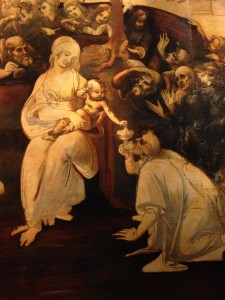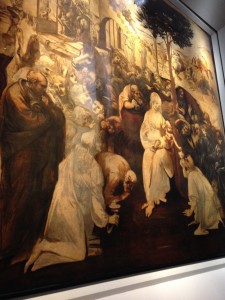“Il cosmo magico di Leonardo da Vinci: l’Adorazione dei Magi restaurata”
Galleria degli Uffizi, dal 28 marzo al 24 settembre 2017
Recensione di Maria Eletta Benedetti (Università degli Studi di Firenze)
L’Adorazione dei Magi di Leonardo torna a “casa”, nella Galleria degli Uffizi dove è conservata dal 1640. Ad accogliere l’opera per questo importante rientro è una mostra dal titolo Il cosmo magico di Leonardo da Vinci: l’Adorazione dei Magi restaurata, curata dal nuovo direttore della Galleria Eike Schmidt e dal Soprintendente dell’Opificio delle Pietre Dure Marco Ciatti. È proprio presso questo prestigioso Istituto che la pala di Leonardo è stata restaurata con un intervento durato circa cinque anni. Le vicende dell’opera, dalla sua origine all’ingresso agli Uffizi, insieme alla descrizione dettagliata sono raccontate nella primissima sala, attraverso un video, semplice ma molto chiaro, sia in italiano (la voce maschile narrante) che in inglese (i sottotitoli). L’opera infatti è stata realizzata, o meglio parzialmente dipinta, tra il 1481 e il 1482 da Leonardo su richiesta dei monaci di San Donato a Scopeto. Dopo la partenza dell’artista-scienziato per Milano, l’Adorazione rimane incompiuta e la commissione passa nel 1496 a Filippino Lippi, al quale viene richiesto di raffigurare in un’altra tavola la stessa tematica sacra. Nella seconda sala è esposta proprio la pala compiuta di Filippino, anch’essa conservata oggi presso gli Uffizi. La scelta di accostare le due opere risulta vincente in quanto permette un confronto tra le alterità dei due pittori e tra le loro opere; ma allo stesso tempo consente di sottolineare i parallelismi tra le due tavole, accomunate dal medesimo soggetto e dalla medesima commissione. Tuttavia a livello espositivo la scelta del posizionamento dell’opera non è molto buona. L’opera filippesca è stata collocata di fianco all’ingresso della sala ed entrando il visitatore trova la grande tavola subito sul suo fianco destro. Con questa disposizione forse l’Adorazione di Fillippino viene svilita nella sua fruizione, perché per essere osservata il visitatore deve mettersi in mezzo all’accesso della sala successiva oppure deve guardala ad una distanza ravvicinata che permette solo una visione parziale dell’opera considerando invece le grandi dimensioni (258×243 cm). Da questa stanza, che ha anche una funzione di snodo, si aprono altre due sale: una sulla destra nella quale vi è un altro filmato interamente dedicato al meraviglioso restauro; l’altra sulla sinistra nella quale è esposta l’opera di Leonardo. Grazie all’allestimento assolutamente essenziale si percepisce che l’Adorazione leonardesca è la protagonista indiscussa, non ha bisogno di presentazioni (non c’è una didascalia) e calca così la scena come bellezza assoluta e tutta da scoprire. Grazie ai restauri essa è ancora più incantevole e sembra che l’occhio non si stanchi di ammirarla, curioso di cercare un qualche nuovo dettaglio, un tratto corrucciato o stupito dei volti, una posa delle figure sullo sfondo. La sala è tutta bianca (riprendendo il colore delle nuove sale botticelliane) ed è illuminata sapientemente. L’opera leonardesca è posta in una struttura leggermente incassata e protetta da un vetro che non disturba assolutamente la visione con riflessi. Nella sala dove è allestito il video dedicato ai restauri vi sono anche due pannelli che riproducono in formato originale l’opera prima dell’intervento. Forse sarebbe stato interessante vedere anche un pannello che riproducesse il retro della tavola.
Questa piccola mostra è collocata all’interno delle Gallerie dopo gli spazi dedicati alle esposizioni, che si trovano al primo piano, accanto alle sale rosse.
Translation by: Rachyl Grussing (Istituto Lorenzo de’ Medici)
“The Magic Cosmos of Leonardo da Vinci: The Restored Adoration of the Magi”
The Adoration of the Magi by Leonardo returns “home”, in the Uffizi Gallery where it has been conserved since 1640. In addition to the important re-entry of this work is the exhibition entitled, ‘The Magic Cosmos of Leonardo da Vinci: The Adoration of the Magi Restored’, curated by the new director Eike Schmidt and the Superintendent of the Office of Dure Stone Marco Ciatti. It is at this prestigious Institute that Leonardo’s palace has been restored with an intervention lasting about five years. The events of the work, from its origins in the Uffizi, together with a detailed description are told in the first room through a video which is simple but very clear, in both Italian (the voice of the masculine narrator) and in English (the subtitles).
The work was in fact partially realized, or better yet partially painted, between 1481 and 1482 by Leonardo on the request of the monks of San Donato and Scopeto. After the departure of the artist/scientist for Milan, the Adoration remained incomplete and the commission passed in 1496 to Filippino Lippi, who was asked to represent the same sacred theme at another table.
In the second room of the show is the finished work of Filippino, which is also kept at the Uffizi. The choice to approach the two works wins as it allows for comparison between the otherness between the two painters and their works, but also underlines the parallels between the two tables, accompanied by the same subject and the same commission.
However, at the exhibition level, the choice of the placement of the works is not good. The Filippino Lippi work is placed alongside the entrance of the room and upon entrance the visitor suddenly finds a large table to the right. With this arrangement maybe the Filippino Adoration is thought to come to its fruition, because to be observed by the visitor, they must be in the middle of the doorway to the next room, or they must look at a distance that permits only one visitor to partially view the large dimensions of the work (258x243cm). From this room, which also has another function, open two other rooms: a room on the right in which is entirely dedicated to the wonderful restoration, the other on the left in which is displayed the work of Leonardo.
Thanks to the absolutely essentially setting, it is perceived that the Leonardo Adoration is the protagonist of the exhibition, and does not need presentation (it has no caption), and so the absolutely beautiful scene can be discovered by all. Thanks to the restoration it is even more enchanting and so it seems that the eye does not get tired of admiring it, curious to look for some new detail, a curve or amazing stretch of faces, a pose of figures in the background. The room is completely white (mirroring the color of the new Botticelli rooms) and the lighting is used wisely. The work of Leonardo is placed in a slightly embedded structure protected by a glass that does not disturb the vision with reflections. In the room where the video dedicated to the restoration is set up are also two panels that reproduce the original format of the work before the intervention. Maybe it would have been interesting to see also a panel reproducing the back of the table.
This small exhibition is located inside the Gallery in the exhibition spaces, which are located on the first floor, after the Red Rooms.

